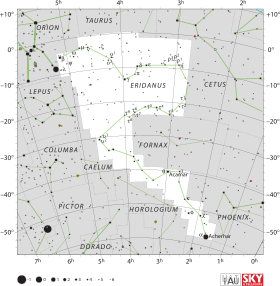
Castor is the second-brightest object in the zodiac constellation of Gemini. It has the Bayer designation α Geminorum, which is Latinised to Alpha Geminorum and abbreviated Alpha Gem or α Gem. With an apparent visual magnitude of 1.93, it is one of the brightest stars in the night sky. Castor appears singular to the naked eye, but it is actually a sextuple star system organized into three binary pairs. Although it is the 'α' (alpha) member of the constellation, it is fainter than 'β' (beta) Geminorum, Pollux.

Iota Orionis is a multiple star system in the equatorial constellation of Orion the hunter. It is the eighth-brightest member of Orion with an apparent visual magnitude of 2.77 and also the brightest member of the asterism known as Orion's Sword. It is a member of the NGC 1980 open cluster. From parallax measurements, it is located at a distance of roughly 1,340 light-years from the Sun.

DV Aquarii is a binary star system in the zodiac constellation of Aquarius. It has a peak apparent visual magnitude of 5.89, which is bright enough to be visible to the naked eye. The distance can be estimated from its annual parallax shift of 11.2 mas, yielding a separation of 291 light years.

IU Aurigae is a triple star system in the constellation Auriga, consisting of an eclipsing binary pair orbiting a third component with a period of 335 years. This system is too faint to be viewed with the naked eye, having a peak apparent visual magnitude of 8.19. The eclipsing pair form a Beta Lyrae-type semidetached binary of two Bp stars with a period of 1.81147435 days. During the primary eclipse, the visual magnitude of the system drops to 8.89, while for the secondary it decreases to 8.74. The third component is a massive object with 17–18 M☉, and may actually be a binary – which would make this a quadruple star system.

S Monocerotis, also known as 15 Monocerotis, is a massive multiple and variable star system located in the constellation Monoceros. It is the brightest star in the Christmas Tree open cluster in the area catalogued as NGC 2264.

WR 22, also known as V429 Carinae or HR 4188, is an eclipsing binary star system in the constellation Carina. The system contains a Wolf-Rayet (WR) star that is one of the most massive and most luminous stars known, and is also a bright X-ray source due to colliding winds with a less massive O class companion. Its eclipsing nature and apparent magnitude make it very useful for constraining the properties of luminous hydrogen-rich WR stars.
HD 29573 is a binary star system in the constellation Eridanus. It has a combined apparent visual magnitude of 4.99, making it visible to the naked eye. Based upon an annual parallax shift of 15 mas, it is located 217 light years from the Sun. The system is moving further away from Earth with a heliocentric radial velocity of +3 km/s.
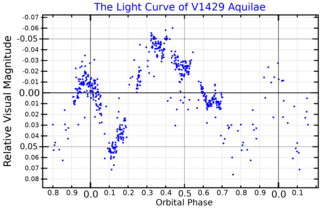
V1429 Aquilae is a candidate luminous blue variable multiple star system located in the constellation of Aquila. It is often referred to by its Mount Wilson Observatory catalog number as MWC 314. It is a hot luminous star with strong emission lines in its spectrum.

κ Delphini is a binary star system in the constellation Delphinus. It is faintly visible to the naked eye, with an apparent magnitude of 5.05. It is located about 98.8 light-years away, based on its parallax.

14 Lacertae is a binary star system in the northern constellation Lacerta, located around 1,600 light years away. It has the variable star designation V360 Lacertae; 14 Lacertae is the Flamsteed designation. The system is barely visible to the naked eye in good seeing conditions, having a peak apparent visual magnitude of 5.91. It is moving closer to the Earth with a heliocentric radial velocity of −16 km/s.
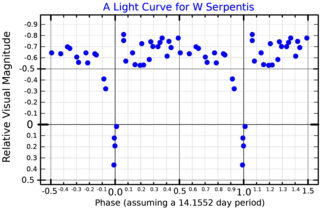
W Serpentis is an eclipsing binary star in the constellation Serpens. It is always too faint to be seen with the naked eye, varying between apparent magnitudes 8.42 and 10.2 with a period of just over 14 days. This is mainly due to eclipses; however, variations in its period indicate there are some innate changes in luminosity of one or both component stars as they interact with each other, and it has been difficult to disentangle the light to determine their nature. The period is increasing by 14 seconds a year, indicating that a massive amount of material is being transferred from the larger fainter star to the smaller brighter one.

VV Orionis is an eclipsing binary located in the belt region of the constellation Orion. It is a faint naked eye star.
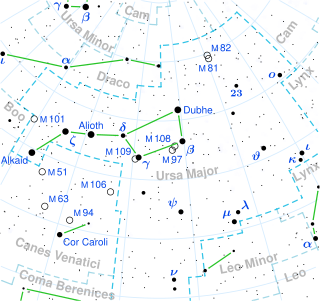
65 Ursae Majoris, abbreviated as 65 UMa, is a star system in the constellation of Ursa Major. With a combined apparent magnitude of about 6.5, it is at the limit of human eyesight and is just barely visible to the naked eye in ideal conditions. It is about 760 light years away from Earth.
Phi Phoenicis, Latinized from φ Phoenicis, is a binary star system in the southern constellation of Phoenix. It is faintly visible to the naked eye with an apparent visual magnitude of 5.1. Based upon an annual parallax shift of 10.185 mas as seen from Earth, it is located approximately 320 light years from the Sun. It is moving away with a heliocentric radial velocity of 10.4 km/s.

AD Andromedae is an eclipsing binary in the constellation Andromeda. Its maximum apparent visual magnitude is 11.2, but it shows a decrease of 0.62 magnitudes during the main eclipse and 0.58 during the secondary one. It is classified as a Beta Lyrae variable star with a period of almost one day.
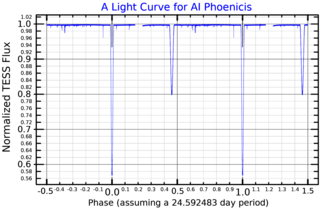
AI Phoenicis is a variable star in the constellation of Phoenix. An Algol-type eclipsing binary, its apparent magnitude is constant at 8.58 for most of the time, sharply dropping to 9.35 during primary eclipse and to 8.89 during secondary eclipse. The system's variability was discovered by W. Strohmeier in 1972. From parallax measurements by the Gaia spacecraft, the system is located at a distance of 560 light-years from Earth, in agreement with earlier estimates based on its luminosity.
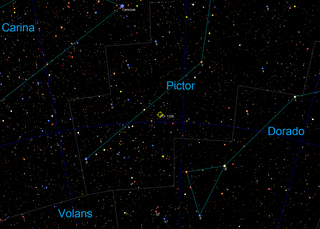
TOI-1338 is a binary star system located in the constellation Pictor, about 1,320 light-years from Earth. It is orbited by two known circumbinary planets, TOI-1338 b, discovered by the Transiting Exoplanet Survey Satellite (TESS) and BEBOP-1c, discovered by the Binaries Escorted By Orbiting Planets project.

HD 193322 is a group of six stars which appear to be at least loosely bound into a system in the constellation Cygnus. The stars comprise the core of the young open cluster Collinder 419, which contains a total of 51 known stars. Another prominent member of the cluster is the eclipsing binary star V470 Cygni. The cluster lies at a distance of about 3500 light years and its stars are only a few million years old.

HD 139319 is a ternary system composed of the binary Algol variable star known as TW Draconis, and a main-sequence companion star at a separation of 3 arcseconds. The system lies in the constellation of Draco about 540 light years away.

HS Hydrae is a triple star system in the equatorial constellation of Hydra. The inner pair were an eclipsing binary during the period 1920 until 2019, with HS Hya being the variable star designation. With a base apparent visual magnitude of 8.08, HS Hya is too dim to be viewed with the naked eye. During the primary eclipse, the magnitude dropped to 8.61; the secondary eclipse lowered the magnitude to 8.55. Based on parallax measurements, the system is located at a distance of approximately 335 light years from the Sun. It is drifting closer with a mean radial velocity of −7 km/s.
